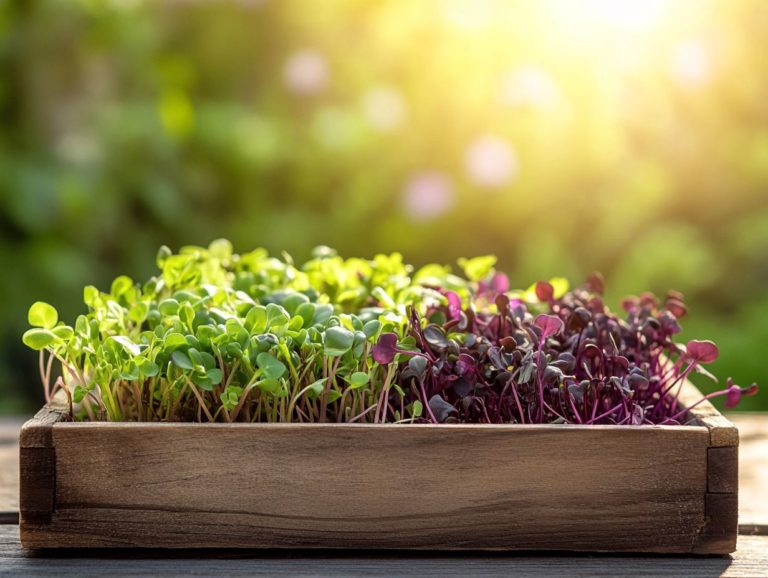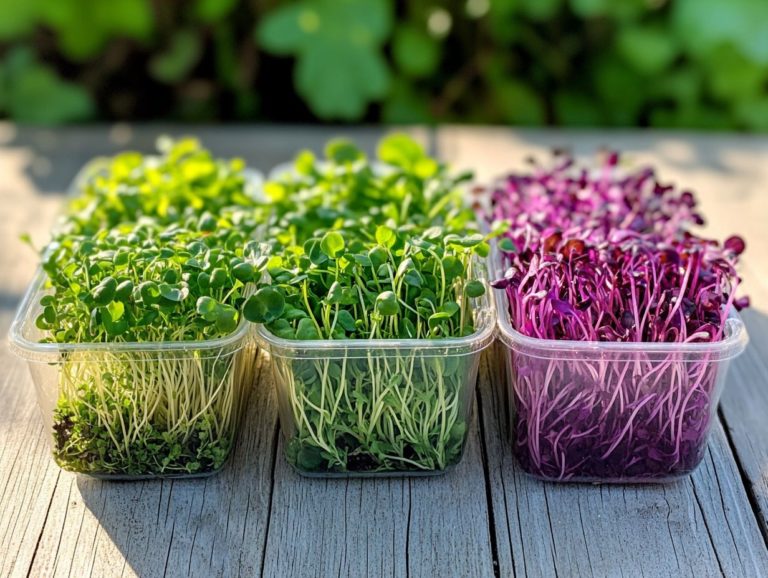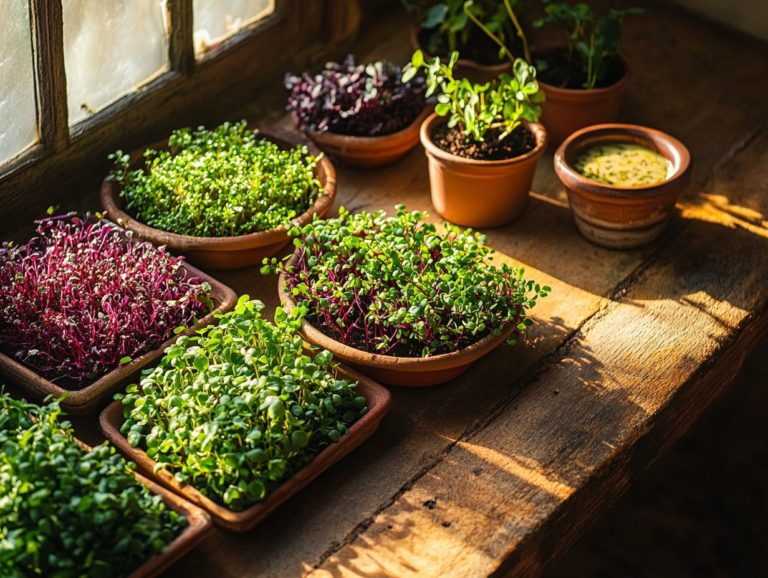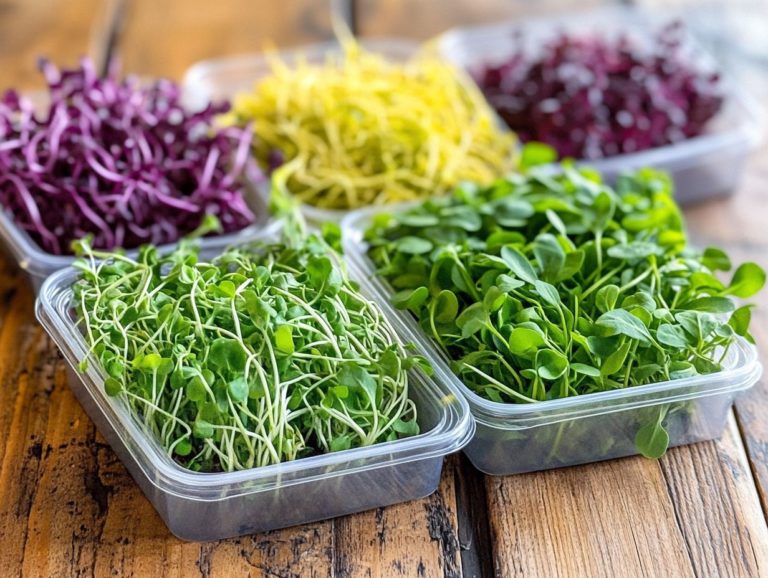How Microgreens Support Immune Health
Microgreens are delightful, tiny plants bursting with nutrients that can elevate both your flavor profiles and health!
These greens come in various types. Each has impressive nutritional benefits. Dive into the world of microgreens and uncover their definitions and types!
You ll also learn about specific varieties that particularly bolster immunity, along with innovative ways to incorporate them into your meals. If you’re feeling adventurous, there s a step-by-step guide to help you grow your own microgreens at home.
Discover how these little greens can make a significant impact on your health, especially through their concentrated nutrients and health-promoting properties.
Contents
- Key Takeaways:
- What are Microgreens?
- Nutritional Value of Microgreens
- Microgreens and Immune Health
- Specific Microgreens for Immune Support
- Incorporating Microgreens into Your Diet
- Growing Your Own Microgreens
- Frequently Asked Questions
- Why are microgreens great for your immune health?
- Which vitamins and minerals in microgreens help boost immunity?
- Do all types of microgreens have immune-boosting properties?
- How do antioxidants in microgreens support immune health?
- Can microgreens help prevent illnesses and infections?
- How can I incorporate microgreens into my diet for immune support?
Key Takeaways:
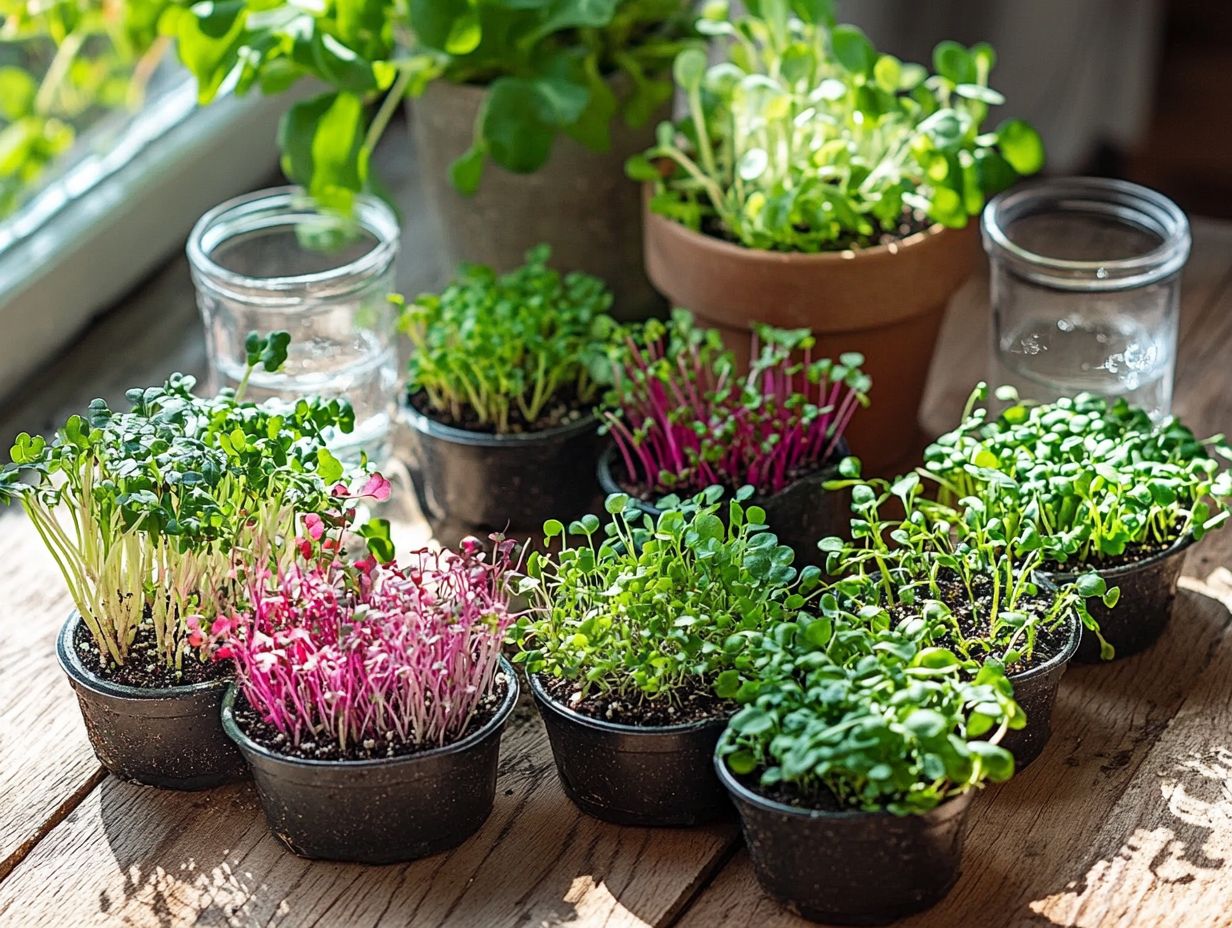
- Adding microgreens to your diet can strengthen your immune system and help fight off illnesses.
- Microgreens are packed with essential vitamins and minerals that play a vital role in supporting immune health.
- You can easily grow and incorporate a variety of microgreens into your diet for delicious and nutritious meals.
What are Microgreens?
Microgreens are young, edible plants that you harvest just after the first true leaves emerge. Often called vegetable confetti, these nutrient-dense greens not only catch the eye but are also brimming with concentrated nutrients, vitamins, and antioxidants.
They come from various plant families, including those that produce familiar vegetables like broccoli and cabbage, featuring popular varieties like broccoli, radish, kale, and assorted culinary herbs.
Their rising popularity in growing plants in the city and upscale restaurants can be traced to their vibrant flavors and health benefits, making them an essential component in contemporary culinary creations.
Definition and Types
Microgreens, often called baby greens, are a delightful addition to your culinary repertoire. These tiny plants hail from a variety of families and are celebrated for their compact size and bold flavors.
Typically harvested at the seedling stage, they encompass a diverse array of varieties, each boasting its own unique taste and nutritional benefits. Among the most popular options, you’ll encounter vibrant radish microgreens that deliver a peppery kick, alongside sweet basil, prized for its aromatic essence in Italian cuisine.
Pea shoots, with their tender texture and sweet flavor, elevate salads and sandwiches to new heights. Don t overlook other notable varieties like cilantro, which adds a refreshing brightness to salsas and tacos, or beet microgreens, distinguished by their stunning color and earthy flavor.
The culinary potential of these greens is vast, offering endless opportunities for creativity in both raw and cooked dishes. It’s no wonder they have become a beloved choice for chefs and home cooks alike.
Nutritional Value of Microgreens
Microgreens are celebrated for their exceptional nutritional benefits, boasting a remarkable concentration of vitamins, minerals, and antioxidants that outshine their fully grown counterparts.
Research indicates that these petite greens can pack in up to 40 times more nutrients than mature vegetable greens, positioning them as a powerhouse addition to any health-conscious diet.
With high levels of vitamins A, C, E, and K, along with essential minerals and bioactive compounds, they play a significant role in promoting health, bolstering immune function, and reducing the risk of chronic diseases.
Ready to boost your meals? Start growing your own microgreens today!
Key Vitamins and Minerals
Microgreens are a treasure trove of essential vitamins and minerals, making them an essential addition to your diet. They often pack more nutrients than their fully grown counterparts, offering a concentrated source of key vitamins such as A, C, E, and K, along with critical minerals like calcium and iron.
These young, tender greens not only elevate your culinary creations, but they also act as formidable allies in enhancing your health. For example, vitamin A is vital for vision and immune function. Vitamin C serves as a powerful antioxidant, aiding in tissue repair and bolstering your body’s defenses. Vitamin K plays a crucial role in maintaining bone health, and calcium is key for robust bones and teeth. To learn more about their benefits, check out the health benefits of microgreens explained.
Iron, abundant in select varieties, is essential for energy production and efficiently transporting oxygen in your bloodstream. By incorporating microgreens into your meals, you can effortlessly boost your intake of these vital nutrients. Explore different options with microgreen varieties and their health benefits, ultimately supporting your overall wellness and vitality.
Microgreens and Immune Health
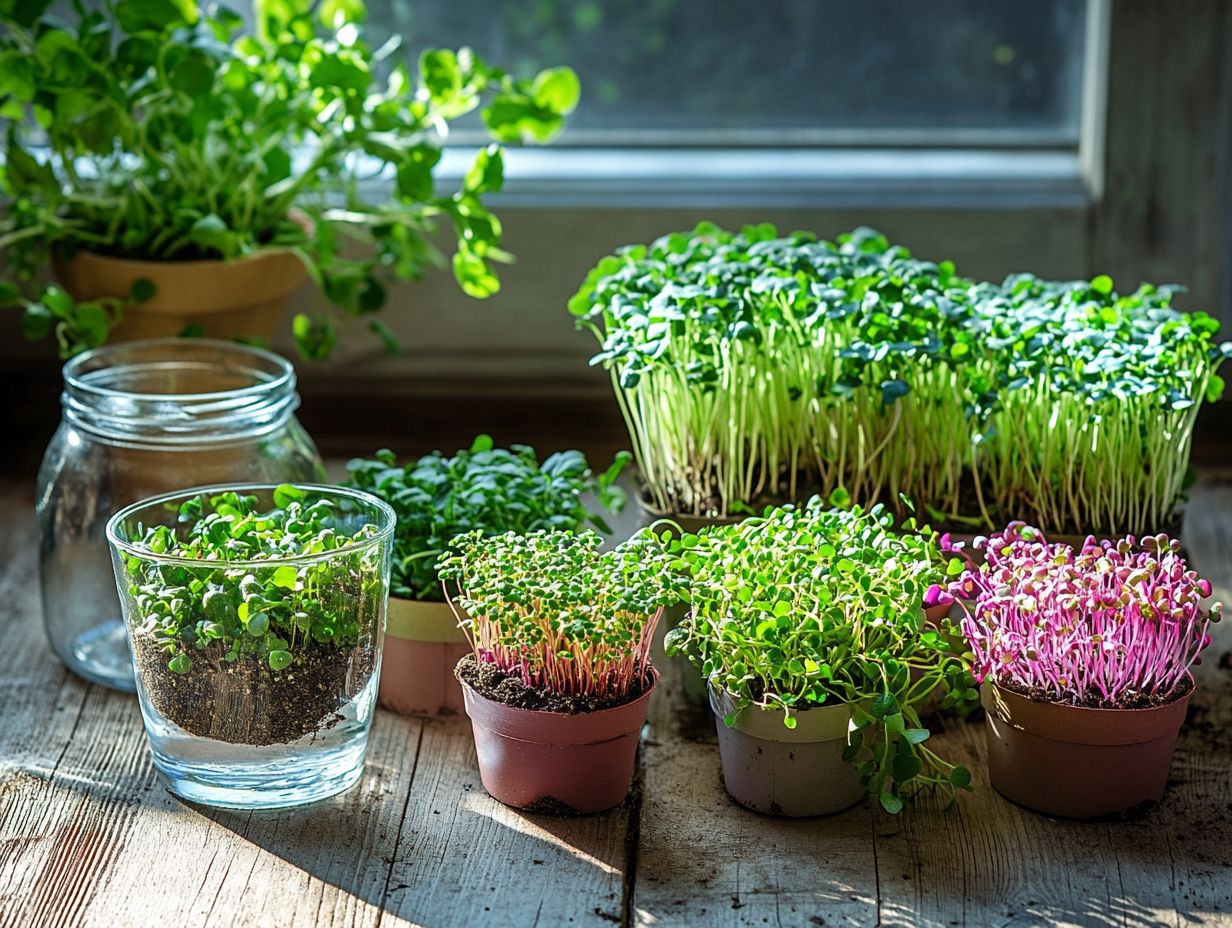
Microgreens are key to improving immune health. They provide an abundance of antioxidants and plant compounds that bolster the immune system’s functions. Their impressive antioxidant profile combats oxidative stress and inflammation two critical elements in sustaining a strong immune response.
By integrating these nutrient-dense powerhouses into your daily meals, you can unlock a spectrum of health benefits, including microgreens: the secret to healthy skin, that strengthen your immune defenses against illness and disease.
How They Boost Immunity
Microgreens serve as a powerful ally for enhancing your immune defense, thanks to their abundant antioxidants and plant compounds that neutralize free radicals and reduce inflammation. By integrating these petite greens into your meals, you’re actively supporting your body’s immune system while elevating your overall health.
These tiny powerhouses are rich in essential vitamins like C, E, and K. They also deliver a healthy dose of minerals such as zinc and magnesium, both crucial for fortifying your immune response. In fact, the benefits of eating microgreens daily include enhancing the functionality of white blood cells, allowing them to effectively combat pathogens.
Additionally, the high fiber content in microgreens promotes gut health, which is vital since a significant part of your immune system resides in the gut. By including a variety of microgreens, think broccoli, radish, and mustard greens, you can create a dynamic blend of nutrients. Consider exploring microgreen varieties that boost your immune system to maximize their health benefits.
Specific Microgreens for Immune Support
Certain microgreens stand out for their remarkable immune-supporting properties, making them exceptional choices for enhancing your health. Varieties like broccoli, radish, and kale are celebrated not only for their vibrant flavors but also for their impressive antioxidant content.
These greens are packed with vitamins and plant compounds that play a vital role in promoting immune health, offering you a delightful and nutritious way to strengthen your body’s defenses. Exploring the top microgreen varieties for health enthusiasts can help you incorporate these benefits into your diet.
Top Varieties and Their Benefits
- Broccoli microgreens are loaded with sulforaphane, a compound linked to immune support and detoxification.
- Radish microgreens add a peppery kick to your dishes while delivering high levels of vitamins A, C, and E essential nutrients for skin health and fighting oxidative stress.
- Kale microgreens, rich in vitamin K and antioxidants, boost bone health and add a subtle earthiness to your salads and smoothies.
- Basil and cilantro microgreens infuse your meals with aromatic flavors and can be easily incorporated into different cooking methods.
Together, these microgreens enhance your nutrition while bringing vibrant colors and textures to your diverse meals. Experience the power of microgreens today!
Incorporating Microgreens into Your Diet
Incorporating microgreens into your diet offers a delightful and beneficial experience. They present numerous cooking options that enhance both flavor and nutrition.
These petite greens can effortlessly elevate a range of dishes, from vibrant salads and hearty sandwiches to refreshing smoothies and elegant garnishes. They are remarkably versatile!
With their bold flavors and concentrated nutrients, microgreens not only boost your nutrient intake but also add an appealing aesthetic to your meals, making them superfoods you need.
Delicious and Creative Ways to Enjoy Them
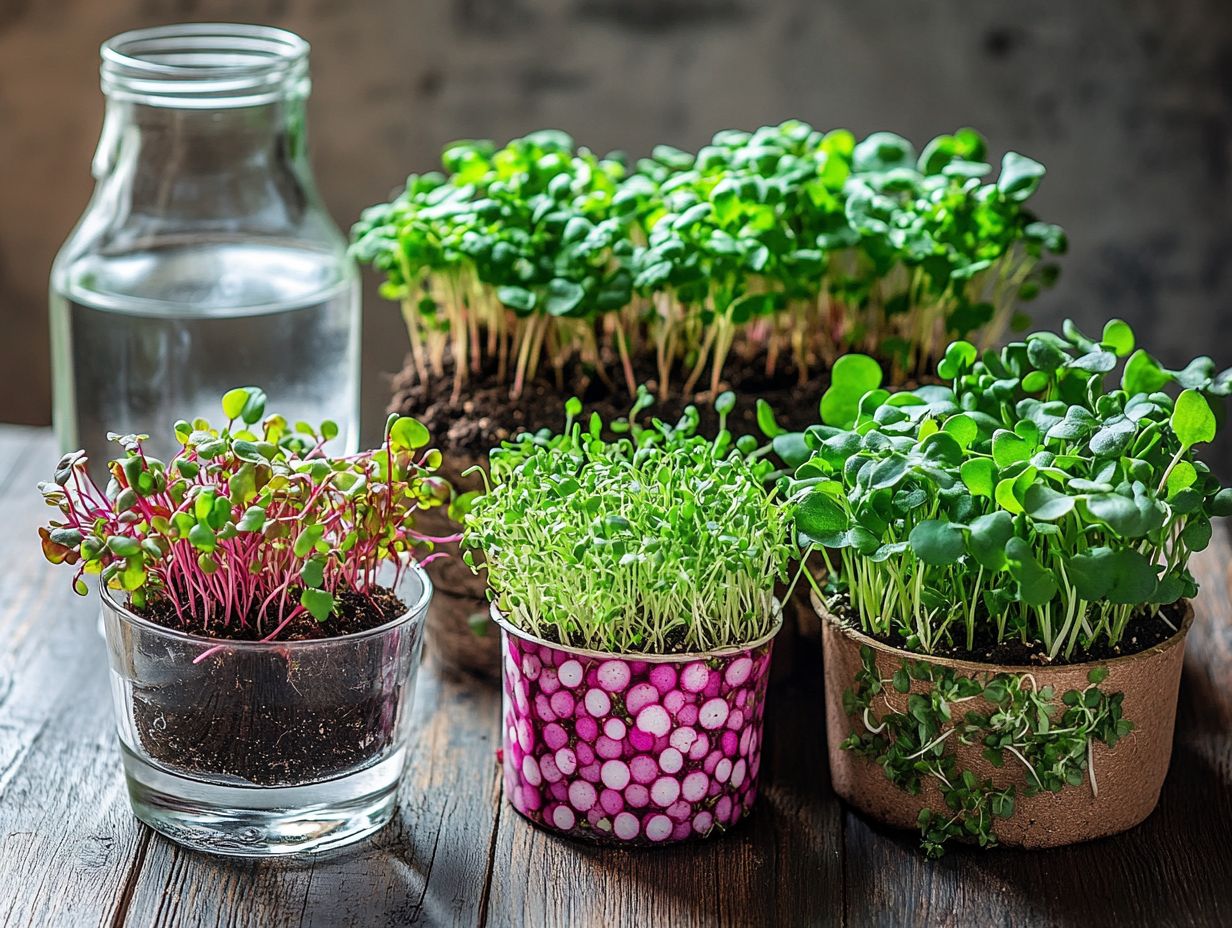
There are countless delicious and creative ways for you to enjoy microgreens in your meals! From topping soups and salads to blending them into smoothies or using them as garnishes, the possibilities are endless.
These tiny powerhouses add a vibrant pop of color and pack a serious nutritional punch. Imagine delicious omelets packed with flavor!
Consider incorporating microgreens into savory omelets or frittatas for breakfast or tossing them into grain bowls for a refreshing lunch.
They enhance the flavor profile of sandwiches and wraps, providing a fresh crunch that elevates even the simplest ingredients.
For dinner, use them to adorn grilled proteins or mix them into pasta dishes for that garden-fresh finish. Whether you sprinkle them over crisp avocado toast or use them as a vibrant bed for sushi, microgreens cater to every palate!
Growing Your Own Microgreens
Growing your own microgreens is not just accessible; it’s a truly rewarding experience! You can savor fresh, flavorful greens right at home.
Even with limited space and resources, you can thrive in cultivating these nutrient-dense plants. They are perfect for urban farming enthusiasts like you!
By grasping the right growing conditions, choosing high-quality seeds, and following a straightforward guide, you can relish a bountiful harvest of microgreens that cater to your unique taste and nutritional preferences.
Step-by-Step Guide and Tips
A step-by-step guide to growing microgreens at home can transform your gardening journey into a rewarding experience. It all starts with selecting high-quality seeds and understanding the ideal growing conditions.
-
Choose a clean, shallow container that allows for excellent drainage; this is key to nurturing your young plants.
-
Opt for a quality potting mix and moisten it just enough avoid that soggy mess!
-
Once you’ve evenly sown the seeds, gently press them down to ensure they make contact with the soil.
-
Use a spray bottle to water gently; this avoids displacing those precious seeds.
-
Position your container in a warm, bright spot to encourage optimal growth and regularly check moisture levels.
-
When your microgreens reach a few inches tall, grab some clean scissors for a tidy harvest!
Frequently Asked Questions
Why are microgreens great for your immune health?
Microgreens are packed with nutrients, including vitamins, minerals, and antioxidants! These all play a role in supporting a strong immune system.
Which vitamins and minerals in microgreens help boost immunity?

Microgreens contain various vitamins and minerals, including vitamins C, A, and E, as well as iron, zinc, and magnesium. All these are vital for a healthy immune system!
Do all types of microgreens have immune-boosting properties?
Yes, all microgreens have immune-boosting properties, but some may have more than others. For example, broccoli microgreens are high in sulforaphane, known for its powerful immune-boosting effects.
Start adding microgreens to your meals today for a boost of flavor and nutrition!
How do antioxidants in microgreens support immune health?
Antioxidants neutralize free radicals in the body. These free radicals can damage cells and weaken your immune system. Microgreens are packed with antioxidants, making them a fantastic way to support your immune health.
Can microgreens help prevent illnesses and infections?
There s no guarantee that microgreens will prevent illness. However, they can strengthen your body’s natural defenses against germs and pathogens with their immune-boosting properties.
How can I incorporate microgreens into my diet for immune support?
Microgreens are versatile! You can add them to salads, sandwiches, and smoothies easily. Use them as a garnish or toss them into soups and stir-fries for an exciting nutrient boost!

